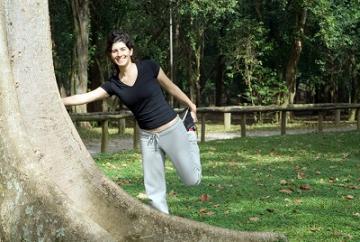Hamstring injuries can be incredibly painful and they can completely take a running down.
The hamstrings run along the back of the top portion of the leg. If you place your hands on the front of your thighs then pull them around to the back of your leg, you will be holding your leg right in the middle of your hamstring muscle.
This is a strong, large muscle known to burn lots of calories during intense exercise. It connects between the pelvis and the knee, allowing the leg to move around as needed in everyday life.
Since this muscle collects a lot of the strain when the body is running, some runners may end up with overuse injuries in this location.
Hamstring Injuries Explained
There are three different hamstring muscles, all running in the same region between the pelvis and back of the knee. These muscles are charged with propelling the legs forward and bringing them to a stop, as needed in daily life and sports. These muscles also support running and jumping, along with other motions that require a lot of force from the lower body.
Hamstring injuries occur when one or more of these muscles are pulled beyond comfort, strained from intense activity, or ruptured from extreme intensity or perhaps an accident. There are different hamstring injuries that can occur from running, and some are much more serious than others.
Many runners do not worry about hamstring injuries because they assume these large muscles are strong and flexible. While this is true, they are still vulnerable to strain and tears just like any other muscle in the body. Therefore, runners have to be aware of the signs of trouble.
These injuries can completely take a runner down. The knee will not bend as it should and it will become incredibly painful to move or flex the leg. The pain can be very sharp and is immediate upon injury.
Common Causes
Hamstring injuries occur when the muscles are extended or pulled beyond their natural capacity. This often happen for runners when their muscle is contracting in order to slow the foot as it strikes down on the ground.
Anytime the leg is forced to an immediate stop or thrusting forward for intense action, a strain or pull can take place in the hamstring muscles.
Runners who push their muscles too hard can also overexert, placing too much strain and leading to injury as well.
Treatment Options
Immediate treatment for hamstring injuries involves putting ice on the area and elevating the leg up high. It is important to completely stop all physical activity and stay off the leg at least for a few days.
In most cases, the leg will not function as normal and will have limited range of motion, which will naturally limit the amount of activity that could be completed anyway. If the pain is unbearable, then a more serious injury may have occurred and a doctor should be contacted for evaluation.
Pain from this type of injury can be handled with over-the-counter medication and ice in most cases. More severe injuries may require prescription medication from a doctor, but in most cases that is unnecessary.
After a period of rest, the muscles can be gently stretched and light activity can resume. This may take longer for some injuries, leaving runners out of the game for up to a month in some cases. The amount of time it takes to start putting weight down on the leg and walking around normally depends on the extent of the injury and the amount of rest and ice it receives during the recovery period.
How to Prevent Hamstring Injuries
The best prevention measures for injury to the hamstring muscles include building up strength in the lower body and not pushing the body too hard, too soon. Runners must pay attention to their legs when they run, noting when they feel too much strain or a bit of tension or pain. If the initial signs of strain are picked up on, the intensity can be taken down so an injury is avoided.
These injuries can also be prevented by building up strength in the gluteus, thighs, calves and other muscles in the lower body. When the surrounding muscles are stronger, they absorb more of the strain placed on the legs in running. This means less strain on the hamstrings, and less risk of stressing them out beyond their capacity for endurance.
Strengthening exercises that target the lower body muscles in general will help support the hamstrings during runs and other daily activities.
Do you want to get more tips on how to prevent and cope with running injuries? You should give Running Doc’s Guide to Healthy Running, written by Lewis Maharam, definitely a try!
Recommended further reading:
- How to prevent achilles tendonitis
- How to prevent ankle sprains
- How to prevent blisters
- How to prevent DOMS
- How to prevent muscle cramps
- How to prevent overtraining syndrome
- How to prevent plantar fasciitis
- How to prevent shin splints
- How to prevent stress fractures
Return from Hamstring Injuries to Running Injuries
Return to Marathon Training Tips home

